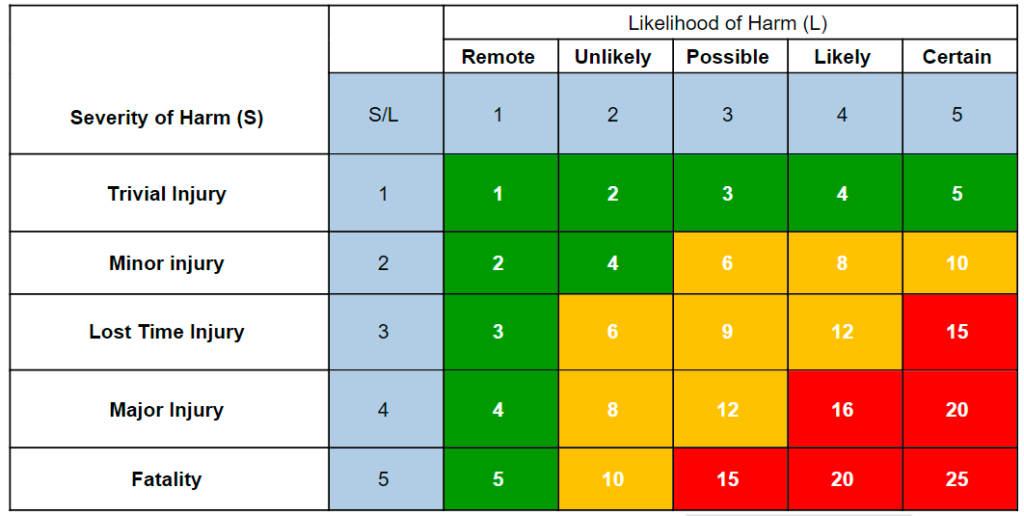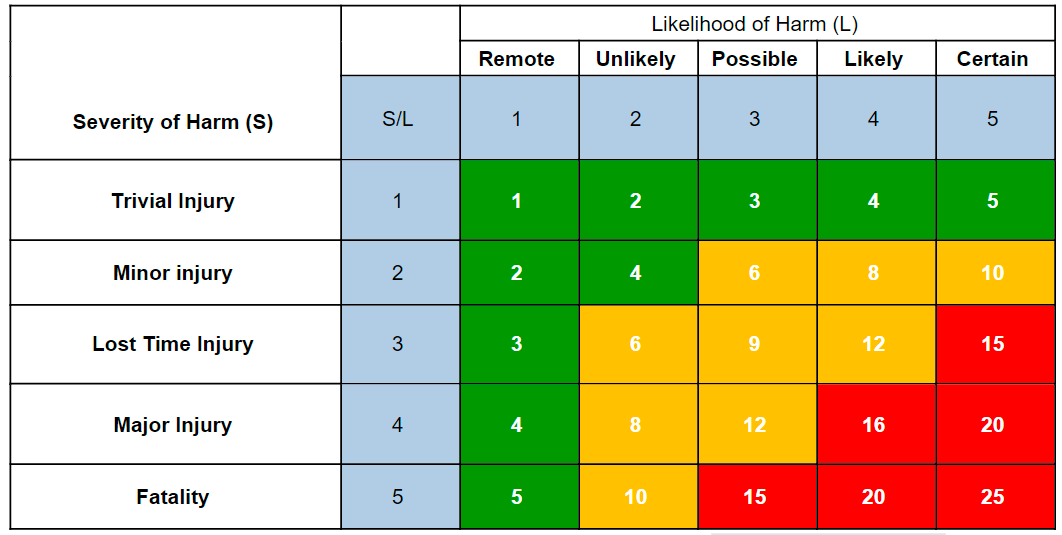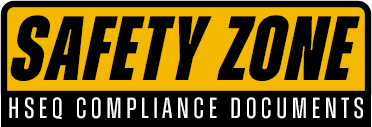Device Not Supported
Sorry your device is not supported. Please use a desktop environment to use this service
| RISK ASSESSMENT FORM | Upload Your Logo | |
| Company Name: | Client / Site: | |
| Task/Activity: | ||
| Ref No: | Date of Assessment: | Review Date: |
| RISK / HAZZARD | Persons at Risk | Significant Hazards and The Risks From Them | Risk Factor (RF) With no control measures in place Initial Risk Rating | SPECIFIED CONTROL MEASURES | Risk Factor (RF) With control measures in place Controlled Risk Rating | ||||
|---|---|---|---|---|---|---|---|---|---|
| L | S | L x S | L | S | L x S | ||||
| Add New Risk | |||||||||
| Follow up assessment required? | Assessment review date: | ||
IMPORTANT, HOW THIS RISK ASSESSMENT WAS CALCULATED Establish the Severity (S), Likelihood (L) and Risk Factor (RF) by reference to the Matrix below: RF = S x L | Completed By: Position: Signature: | Approved By: Position: Signature: | Generate Your Own Free Risk Assessment Free HSEQ Compliance Documents |
Add New Risk
| Risk | Action |
|---|---|
| Refrigerants (Freon, Ammonia) Exposure | |
| Battery Acids (Lead-acid Batteries) Exposure | |
| Fuel (Diesel and Petrol) Exposure | |
| Mould Exposure | |
| Polychlorinated Biphenyls (PCBs) Exposure | |
| Mercury Exposure | |
| Isocyanates Exposure | |
| Solvent Exposure | |
| Cement Dust Exposure | |
| Lead-Based Paint Exposure | |
| Silica Dust Exposure | |
| Legal and Regulatory Changes | |
| Talent Acquisition and Retention | |
| Economic and Market Volatility | |
| Health Crises and Pandemics | |
| Supply Chain Disruptions | |
| Sustainability and Environmental Impact (Fleet & Logistics) | |
| Miscommunication and Coordination Failures in Management | |
| Insurance and Liability Issues with Subcontracted Drivers | |
| Lack of Training and Familiarisation for Subcontracted Drivers | |
| Driver Fatigue Among Subcontracted Drivers | |
| Subcontractor Compliance and Safety Standards | |
| HGV Overloading | |
| Non-Compliance with LGV Regulations | |
| Inadequate Vehicle Servicing and Maintenance | |
| Vehicle Defects Leading to Accidents | |
| Driver Licensing and Certification Risks | |
| Fuel Price Fluctuation and Management | |
| Cross-border Transportation Challenges | |
| Health and Safety Risks in Warehousing and Material Handling | |
| Cybersecurity Threats in Fleet Management Systems | |
| Environmental Conditions and Natural Disasters | |
| Compliance with Transportation Regulations | |
| Mechanical Failures Leading to Road Incidents | |
| Incorrect Cargo Loading | |
| Cargo Theft | |
| Vehicle Accidents Due to Driver Fatigue | |
| Electrical Hazards (Traffic Management) | |
| Adverse Weather Conditions (Traffic Management) | |
| Manual Handling (Traffic Management) | |
| Slips, Trips, and Falls (Traffic Management) | |
| Struck by Moving Equipment | |
| Vehicle Collisions (Traffic Management) | |
| Emergency Vehicle Access (Traffic Management) | |
| Traffic Delays and Public Frustration | |
| Psychological Stress from High-Risk Environment | |
| Night Work and Reduced Visibility | |
| Equipment Failure | |
| Miscommunication Among Team Members | |
| Vehicle Incursions into Work Zones | |
| Lack of Training (Traffic Management) | |
| Inadequate Traffic Control Measures | |
| Accessibility and Accommodation for Disabilities (Healthcare) | |
| Patient Allergies and Specific Needs | |
| Lack of Emergency Preparedness (Healthcare) | |
| Laser Hazards (Healthcare) | |
| Improper Waste Disposal (Healthcare) | |
| Confidentiality Breaches | |
| Patient Elopement | |
| Inadequate Infection Control | |
| Anesthetic Gases | |
| Pharmaceutical Errors | |
| Medical Equipment Malfunction | |
| Electrical Safety (Healthcare) | |
| Ergonomic Injuries | |
| Mental Health and Stress | |
| Slips, Trips, and Falls (Healthcare) | |
| Workplace Violence (Healthcare) | |
| Radiation Exposure (Healthcare) | |
| Chemical Exposure | |
| Needlestick Injuries | |
| Exposure to Infectious Diseases | |
| Patient Handling | |
| Worker Fatigue | |
| Water and Flooding | |
| Public Interference | |
| Plant and Machinery Operation | |
| Night Work (Roadworks) | |
| Traffic Management (Roadworks) | |
| Electrical Safety | |
| Noise Exposure (Roadworks) | |
| Vehicle Collisions (Roadworks) | |
| Inadequate Worker Training and Supervision | |
| Psychosocial Risks | |
| Noise Pollution | |
| Insufficient Site Security | |
| Lack of Emergency Preparedness | |
| Extreme Weather Conditions | |
| Poor Lighting | |
| Tool Misuse and Malfunction | |
| Structural Collapse | |
| Water Hazards | |
| Scaffolding Collapse | |
| Personal Protective Equipment (PPE) Non-Compliance | |
| Traffic Accidents | |
| Stress and Mental Health Issues | |
| Radiation Exposure | |
| Biological Hazards | |
| Chemical Exposure | |
| Cold Stress | |
| Heat Stress | |
| Electrical Hazards | |
| Confined Spaces | |
| Asbestos Exposure | |
| Falling Objects | |
| Digging near underground pipes, cables and equipment | |
| Working on National Highways under adverse weather conditions | |
| Working on National Highways | |
| Fire | |
| Dust/Fume Inhalation | |
| Use of Sthil Saw/Abrasive Wheels | |
| Use of Hand Tools | |
| Excavation Work/Collapse of Excavation | |
| HAVS | |
| Environment Spillages/Use of Hazardous Substances, Use of Concrete | |
| Noise Exposure | |
| Slips, Trips and Falls, Poor Housekeeping | |
| Manual Handling | |
| Working at Height | |
| Mobile Phone Use on Site | |
| Moving/Use of Plant and Machinery, Re-fuelling of Plant | |
| Use of Electric Leads/Power Tools | |
| General Site Working, Access to the Work |
Calculating Risk Assessments
Establish the Severity (S), Likelihood (L) and Risk Factor (RF) by reference to the Matrix below: RF = S x L
REMEMBER: The risk rating must be calculated both before and after ERCPD and its resulting controls have been applied. This risk rating helps to identify and prioritise areas that require more to be done to reduce the risk.

Low risk factor (1-5) normal safe working methods should suffice. Fine tune controls to further reduce the risk, if possible.
Medium risk factor (6-12) further improvement to control measures need to be considered to reduce the risk.
High risk factor (15-25) improve controls now, consider stopping the activity. Seek advice as appropriate.

PLEASE WAIT DO NOT CLOSE THIS PAGE
We are generating your PDF File
Thank You for using the Health & Safety Zone!
Upload Your Logo
Recalculate The Risk
Enter a Number from 1 to 5
Sign your Risk Assessment
Please Select a Document Version
Let's get started
Please enter your project details for your risk assessment
Upload your Health & Safety Zone Save File:
To Begin Please Select:
Save Your Progress
This will create a save file that you can restore anytime to modify your assessment or create a new assessment without having to start from scratch. Use the load/restore button to load your save file anytime.
